*NURSING > QUESTIONS & ANSWERS > Chapter 49: Endocrine Problems Medical-Surgical Nursing, Questions & answers > Endocrine Problems Le (All)
Chapter 49: Endocrine Problems Medical-Surgical Nursing, Questions & answers > Endocrine Problems Lewis: Medical-Surgical Nursing, 10th Edition (answers/ rationales) 2021
Document Content and Description Below
Chapter 49: Endocrine Problems Medical-Surgical Nursing, Questions & answers MULTIPLE CHOICE 1. A 40-yr-old patient with suspected acromegaly is seen at the clinic. To assist in making the diagnosi... s, which question should the nurse ask? a. “Have you had a recent head injury?” b. “Do you have to wear larger shoes now?” c. “Is there a family history of acromegaly?” d. “Are you experiencing tremors or anxiety?” 2. A patient is scheduled for transsphenoidal hypophysectomy to treat a pituitary adenoma. During preoperative teaching, the nurse instructs the patient about the need to a. cough and deep breathe every 2 hours postoperatively. b. remain on bed rest for the first 48 hours after the surgery. c. avoid brushing teeth for at least 10 days after the surgery. d. be positioned flat with sandbags at the head postoperatively. 3. The nurse is planning postoperative care for a patient who is being admitted to the surgical unit from the recovery room after transsphenoidal resection of a pituitary tumor. Which nursing action should be included? a. Palpate extremities for edema. b. Measure urine volume every hour. c. Check hematocrit every 2 hours for 8 hours. d. Monitor continuous pulse oximetry for 24 hours. 4. The nurse is assessing a male patient diagnosed with a pituitary tumor causing panhypopituitarism. Assessment findings consistent with panhypopituitarism include a. high blood pressure. c. elevated blood glucose. b. decreased facial hair. d. tachycardia and palpitations. 5. Which information will the nurse include when teaching a 50-yr-old male patient about somatropin (Genotropin)? a. The medication will be needed for 3 to 6 months. b. Inject the medication subcutaneously every day. c. Blood glucose levels may decrease when taking the medication. d. Stop taking the medication if swelling of the hands or feet occurs. 6. The nurse determines that demeclocycline is effective for a patient with syndrome of inappropriate antidiuretic hormone (SIADH) based on finding that the patient’s a. weight has increased. c. peripheral edema is increased. b. urinary output is increased. d. urine specific gravity is increased. 7. The nurse determines that additional instruction is needed for a patient with chronic syndrome of inappropriate antidiuretic hormone (SIADH) when the patient makes which statement? a. “I need to shop for foods low in sodium and avoid adding salt to food.” b. “I should weigh myself daily and report any sudden weight loss or gain.” c. “I need to limit my fluid intake to no more than 1 quart of liquids a day.” d. “I should eat foods high in potassium because diuretics cause potassium loss.” 8. A 56-yr-old patient who is disoriented and reports a headache and muscle cramps is hospitalized with possible syndrome of inappropriate antidiuretic hormone (SIADH). The nurse would expect the initial laboratory results to include a(n) a. elevated hematocrit. c. increased serum chloride. b. decreased serum sodium. d. low urine specific gravity. 9. An expected patient problem for a patient admitted to the hospital with symptoms of diabetes insipidus is a. excess fluid volume related to intake greater than output. b. impaired gas exchange related to fluid retention in lungs. c. sleep pattern disturbance related to frequent waking to void. d. risk for impaired skin integrity related to generalized edema. 10. Which information will the nurse teach a patient who has been newly diagnosed with Graves’ disease? a. Exercise is contraindicated to avoid increasing metabolic rate. b. Restriction of iodine intake is needed to reduce thyroid activity.c. Antithyroid medications may take several months for full effect. d. Surgery will eventually be required to remove the thyroid gland. 11. A patient who had a subtotal thyroidectomy earlier today develops laryngeal stridor and a cramp in the right hand upon returning to the surgical nursing unit. Which collaborative action will the nurse anticipate next? a. Suction the patient’s airway. b. Administer IV calcium gluconate. c. Plan for emergency tracheostomy. d. Prepare for endotracheal intubation. 12. Which nursing action will be included in the plan of care for a patient with Graves’ disease who has exophthalmos? a. Place cold packs on the eyes to relieve pain and swelling. b. Elevate the head of the patient’s bed to reduce periorbital fluid. c. Apply alternating eye patches to protect the corneas from irritation. d. Teach the patient to blink every few seconds to lubricate the corneas. 13. A 62-yr-old patient with hyperthyroidism is to be treated with radioactive iodine (RAI). The nurse instructs the patient a. about radioactive precautions to take with all body secretions. b. that symptoms of hyperthyroidism should be relieved in about a week. c. that symptoms of hypothyroidism may occur as the RAI therapy takes effect.d. to discontinue the antithyroid medications taken before the radioactive therapy. 14. Which nursing assessment of a 70-yr-old patient is most important to make during initiation of thyroid replacement with levothyroxine (Synthroid)? a. Fluid balance c. Nutritional intake b. Apical pulse rate d. Orientation and alertness 15. An 82-yr-old patient in a long-term care facility is newly diagnosed with hypothyroidism. The nurse will need to consult with the health care provider before administering the prescribed a. docusate (Colace). c. diazepam (Valium). b. ibuprofen (Motrin). d. cefoxitin (Mefoxin). 16. A patient who was admitted with myxedema coma and diagnosed with hypothyroidism is improving. Discharge is expected to occur in 2 days. Which teaching strategy is likely to result in effective patient self-management at home? a. Delay teaching until closer to discharge date. b. Provide written reminders of information taught. c. Offer multiple options for management of therapies. d. Ensure privacy for teaching by asking the family to leave. 17. A patient with primary hyperparathyroidism has a serum phosphorus level of 1.7 mg/dL (0.55 mmol/L) and calcium of 14 mg/dL (3.5 mmol/L). Which nursing action should be included in the plan of care? a. Restrict the patient to bed rest. b. Encourage 4000 mL of fluids daily. c. Institute routine seizure precautions. d. Assess for positive Chvostek’s sign. 18. A patient develops carpopedal spasms and tingling of the lips following a parathyroidectomy. Which action will provide the patient with rapid relief from the symptoms? a. Administer the prescribed muscle relaxant. b. Have the patient rebreathe from a paper bag. c. Start the PRN O2 at 2 L/min per cannula. d. Stretch the muscles with passive range of motion. 19. A patient who had radical neck surgery to remove a malignant tumor developed hypoparathyroidism. The nurse should plan to teach the patient about a. bisphosphonates to reduce bone demineralization. b. calcium supplements to normalize serum calcium levels. c. increasing fluid intake to decrease risk for nephrolithiasis. d. including whole grains in the diet to prevent constipation. 20. Which finding for a patient who has hypothyroidism and hypertension indicates that the nurse should contact the health care provider before administering levothyroxine (Synthroid)? a. Increased thyroxine (T4) level b. Blood pressure 112/62 mm Hg c. Distant and difficult to hear heart sounds d. Elevated thyroid stimulating hormone level 21. A patient is being admitted with a diagnosis of Cushing syndrome. Which findings will the nurse expect during the assessment? a. Chronically low blood pressure c. Purplish streaks on the abdomen b. Bronzed appearance of the skin d. Decreased axillary and pubic hair 22. A 44-yr-old female patient with Cushing syndrome is admitted for adrenalectomy. Which intervention by the nurse will be most helpful for the patient problem of disturbed body image related to changes in appearance? a. Reassure the patient that the physical changes are very common in patients with Cushing syndrome. b. Discuss the use of diet and exercise in controlling the weight gain associated with Cushing syndrome. c. Teach the patient that the metabolic impact of Cushing syndrome is of more importance than appearance. d. Remind the patient that most of the physical changes caused by Cushing syndrome will resolve after surgery. 23. Which finding indicates to the nurse that the current therapies are effective for a patient with acute adrenal insufficiency? a. Increasing serum sodium levels c. Decreasing serum chloride levels b. Decreasing blood glucose levels d. Increasing serum potassium levels 24. The nurse admits a patient to the hospital in Addisonian crisis. Which patient statement supports the need to plan additional teaching? a. “I frequently eat at restaurants, and my food has a lot of added salt.” b. “I had the flu earlier this week, so I couldn’t take the hydrocortisone.” c. “I always double my dose of hydrocortisone on the days that I go for a long run.” d. “I take twice as much hydrocortisone in the morning dose as I do in the afternoon.” 25. A 29-yr-old woman with systemic lupus erythematosus has been prescribed 2 weeks of highdose prednisone therapy. Which information about the prednisone is most important for the nurse to include? a. “Weigh yourself daily to monitor for weight gain.” b. “The prednisone dose should be decreased gradually.” c. “A weight-bearing exercise program will help minimize risk for osteoporosis.” d. “Call the health care provider if you have mood changes with the prednisone.” 26. The nurse providing care for a patient who has an adrenocortical adenoma causing hyperaldosteronism should a. monitor the blood pressure every 4 hours. b. elevate the patient’s legs to relieve edema. c. monitor blood glucose level every 4 hours. d. order the patient a potassium-restricted diet. 27. The nurse will plan to monitor a patient diagnosed with a pheochromocytoma for a. flushing. c. bradycardia. b. headache. d. hypoglycemia. 28. After a patient with a pituitary adenoma has had a hypophysectomy, the nurse will teach about the need for a. sodium restriction to prevent fluid retention. b. insulin to maintain normal blood glucose levels. c. oral corticosteroids to replace endogenous cortisol. d. chemotherapy to prevent malignant tumor recurrence. 29. Which intervention will the nurse include in the plan of care for a patient with syndrome of inappropriate antidiuretic hormone (SIADH)? a. Encourage fluids to 2 to 3 L/day. b. Monitor for increasing peripheral edema.c. Offer the patient hard candies to suck on. d. Keep head of bed elevated to 30 degrees. 30. A patient has just arrived on the unit after a thyroidectomy. Which action should the nurse take first? a. Observe the dressing for bleeding. b. Check the blood pressure and pulse. c. Assess the patient’s respiratory effort. d. Support the patient’s head with pillows. 31. The nurse is caring for a patient following an adrenalectomy. The highest priority in the immediate postoperative period is to a. protect the patient’s skin. c. balance fluids and electrolytes. b. monitor for signs of infection. d. prevent emotional disturbances. 32. The nurse is caring for a patient admitted with diabetes insipidus (DI). Which information is most important to report to the health care provider? a. The patient is confused and lethargic. b. The patient reports a recent head injury. c. The patient has a urine output of 400 mL/hr. d. The patient’s urine specific gravity is 1.003.ANS: A 33. Which prescribed medication should the nurse expect will have rapid effects on a patient admitted to the emergency department in thyroid storm? a. Iodine c. Propylthiouracil b. Methimazole d. Propranolol (Inderal) 34. Which assessment finding for a 33-yr-old female patient admitted with Graves’ disease requires the most rapid intervention by the nurse? a. Heart rate 136 beats/min c. Temperature 103.8° F (40.4° C) 35. A 37-yr-old patient has just arrived in the postanesthesia recovery unit (PACU) after a thyroidectomy. Which information about the patient is most important to communicate to the surgeon? a. Difficult to awaken. c. Reports 7/10 incisional pain. b. Increasing neck swelling. d. Cardiac rate 112 beats/minute. 36. Which assessment finding of a 42-yr-old patient who had a bilateral adrenalectomy requires the most rapid action by the nurse? a. The blood glucose is 192 mg/dL. b. The lungs have bibasilar crackles. c. The patient reports 6/10 incisional pain. d. The blood pressure (BP) is 88/50 mm Hg. 37. A patient is admitted with diabetes insipidus. Which action will be appropriate for the registered nurse (RN) to delegate to an experienced licensed practical/vocational nurse (LPN/LVN)? a. Titrate the infusion of 5% dextrose in water. b. Administer prescribed subcutaneous DDAVP. c. Assess the patient’s overall hydration status every 8 hours. d. Teach the patient how to use desmopressin (DDAVP) nasal spray. 38. Which information is most important for the nurse to communicate rapidly to the health care provider about a patient admitted with possible syndrome of inappropriate antidiuretic hormone (SIADH)? a. The patient has a recent weight gain of 9 lb. b. The patient complains of dyspnea with activity. c. The patient has a urine specific gravity of 1.025. d. The patient has a serum sodium level of 118 mEq/L. 39. After receiving change-of-shift report about the following four patients, which patient should the nurse assess first? a. A 31-yr-old female patient with Cushing syndrome and a blood glucose level of 244 mg/dL b. A 70-yr-old female patient taking levothyroxine (Synthroid) who has an irregular pulse of 134 c. A 53-yr-old male patient who has Addison’s disease and is due for a prescribed dose of hydrocortisone (Solu-Cortef). d. A 22-yr-old male patient admitted with syndrome of inappropriate antidiuretic hormone (SIADH) who has a serum sodium level of 130 mEq/L 40. Which question will the nurse in the endocrine clinic ask to help determine a patient’s risk factors for goiter? a. “How much milk do you drink?” b. “What medications are you taking?” c. “Are your immunizations up to date?” d. “Have you had any recent neck injuries?” 41. Which finding by the nurse when assessing a patient with a large pituitary adenoma is most important to report to the health care provider? a. Changes in visual field c. Blood glucose 150 mg/dL b. Milk leaking from breasts d. Nausea and projectile vomiting will require the most immediate action? a. New-onset changes in the patient’s voice b. Elevation in the patient’s T3 and T4 levels c. Resting apical pulse rate 112 beats/minute d. Bruit audible bilaterally over the thyroid gland 43. Which information obtained by the nurse in the endocrine clinic about a patient who has been taking prednisone 40 mg daily for 3 weeks is most important to report to the health care provider? a. Patient’s blood pressure is 148/94 mm Hg. b. Patient has bilateral 2+ pitting ankle edema. c. Patient stopped taking the medication 2 days ago. d. Patient has not been taking the prescribed vitamin D. 44. The cardiac telemetry unit charge nurse receives status reports from other nursing units about four patients who need cardiac monitoring. Which patient should be transferred to the cardiac unit first? a. Patient with Hashimoto’s thyroiditis and a heart rate of 102 b. Patient with tetany who has a new order for IV calcium chloride c. Patient with Cushing syndrome and a blood glucose of 140 mg/dL d. Patient with Addison’s disease who takes hydrocortisone twice daily Addison’s disease, which prescribed action will the nurse take first? a. Give 4 oz of fruit juice orally. b. Recheck the blood glucose level. c. Infuse 5% dextrose and 0.9% saline. d. Administer O2 therapy as needed. 1. A patient is to receive methylprednisolone (Solu-Medrol) 100 mg. The label on the medication states: methylprednisolone 125 mg in 2 mL. How many milliliters will the nurse administer? [Show More]
Last updated: 1 year ago
Preview 1 out of 15 pages
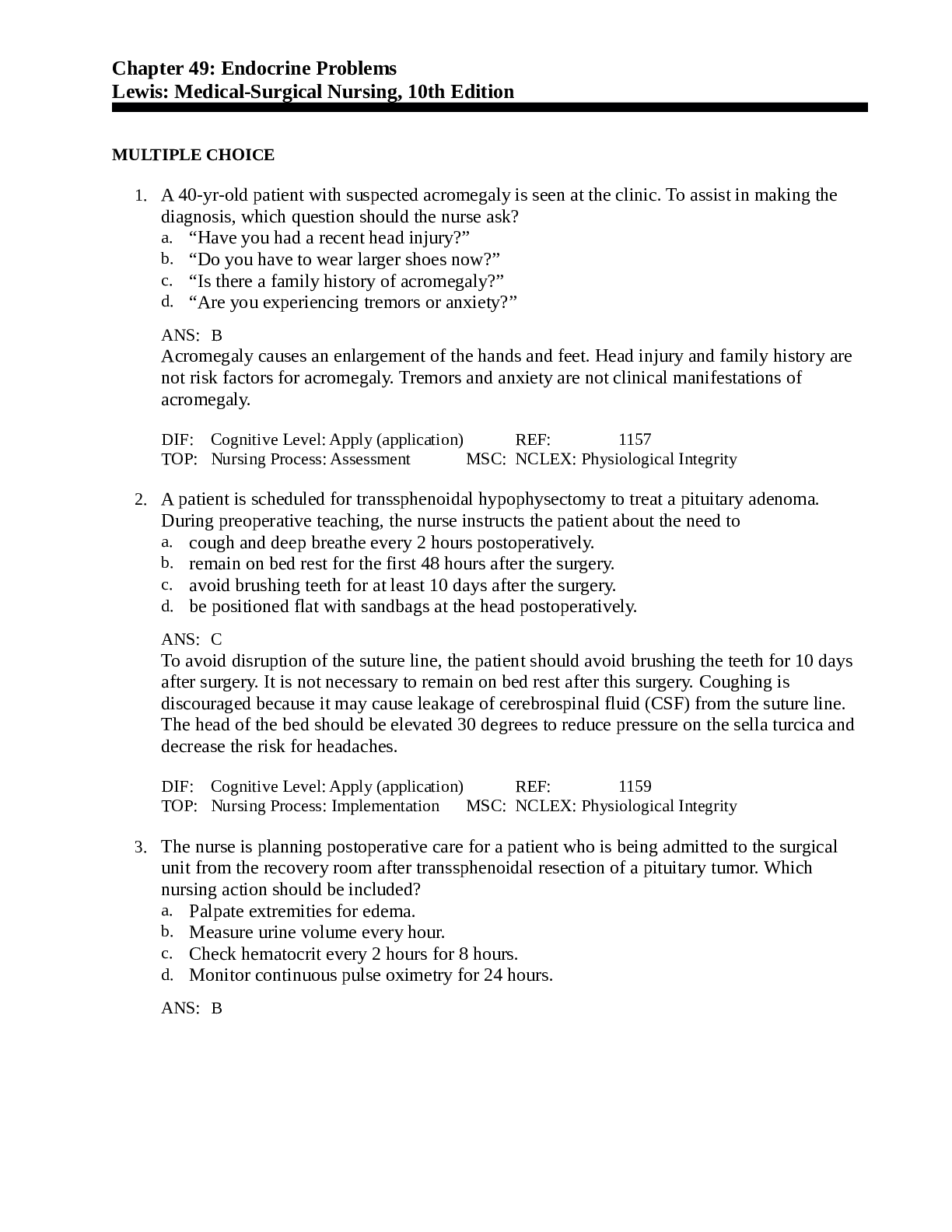
Buy this document to get the full access instantly
Instant Download Access after purchase
Add to cartInstant download
We Accept:

Reviews( 0 )
$10.00
Document information
Connected school, study & course
About the document
Uploaded On
Mar 29, 2021
Number of pages
15
Written in
Additional information
This document has been written for:
Uploaded
Mar 29, 2021
Downloads
0
Views
111

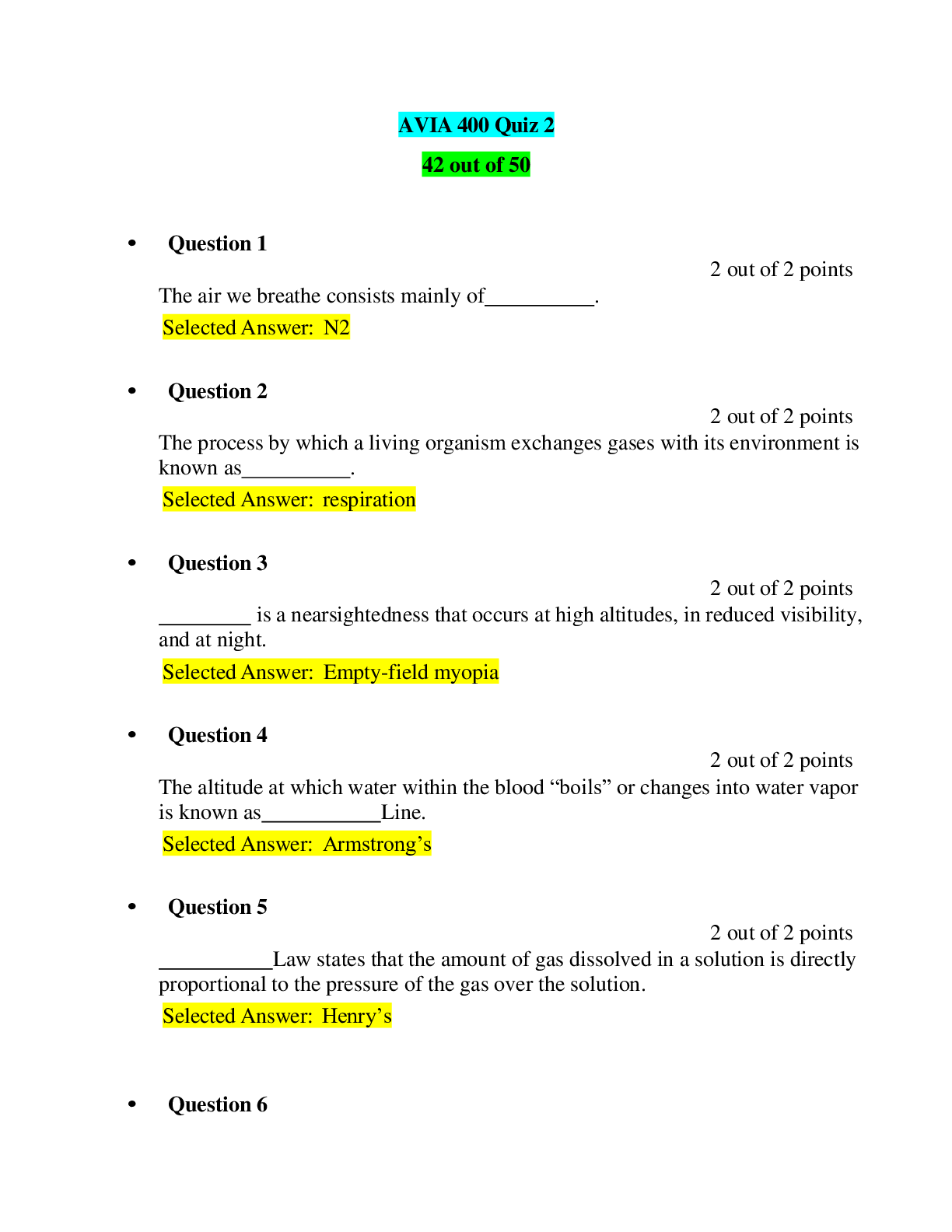

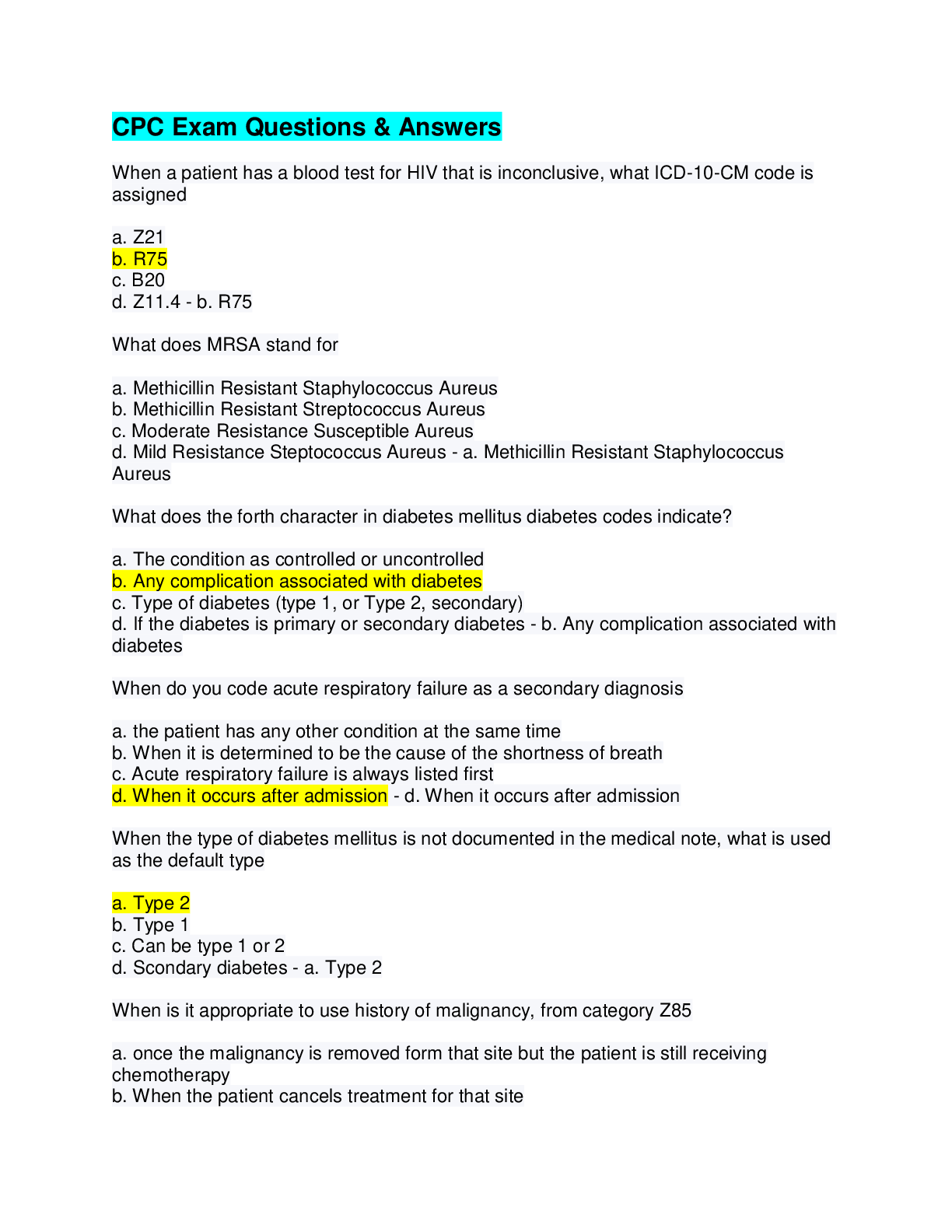
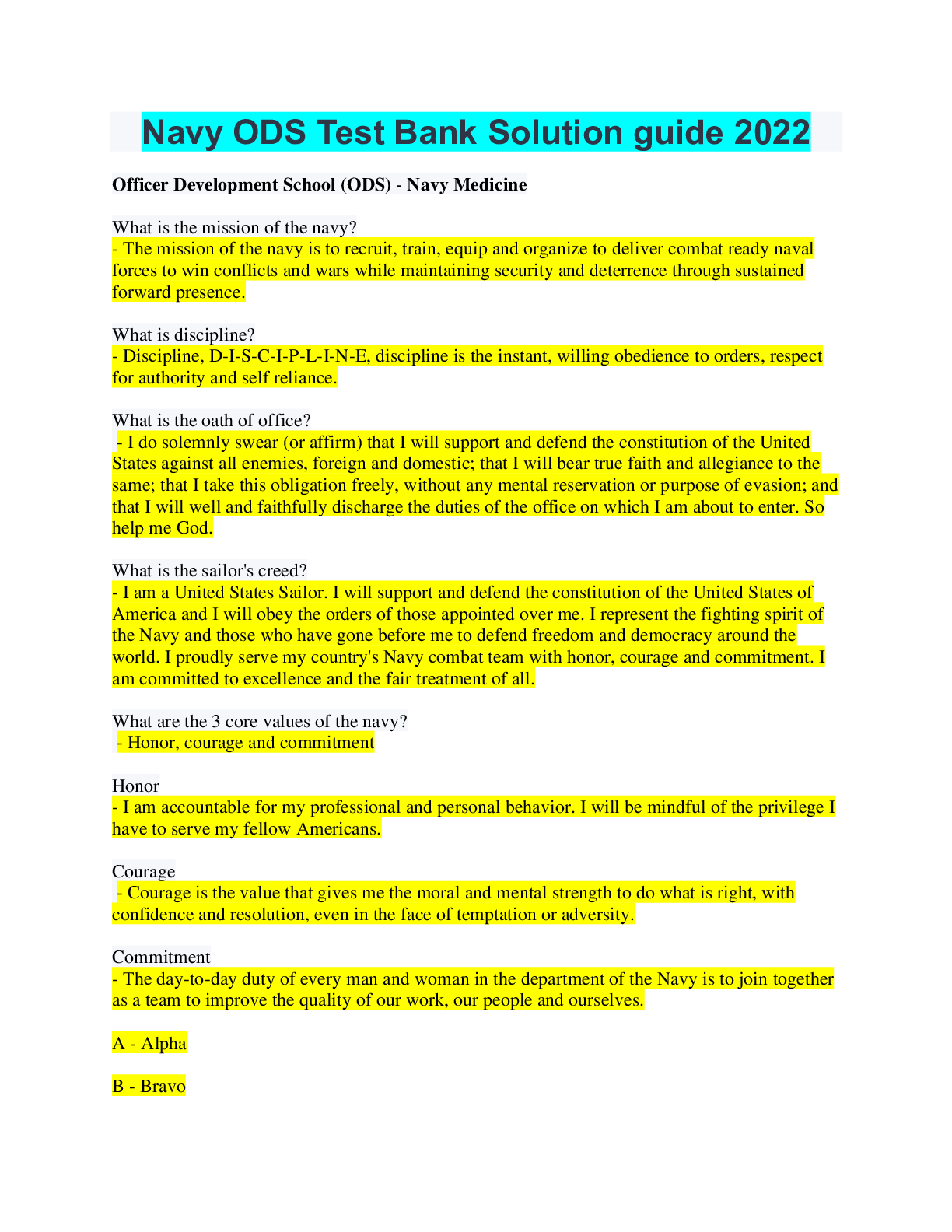



 Summer 2022.png)


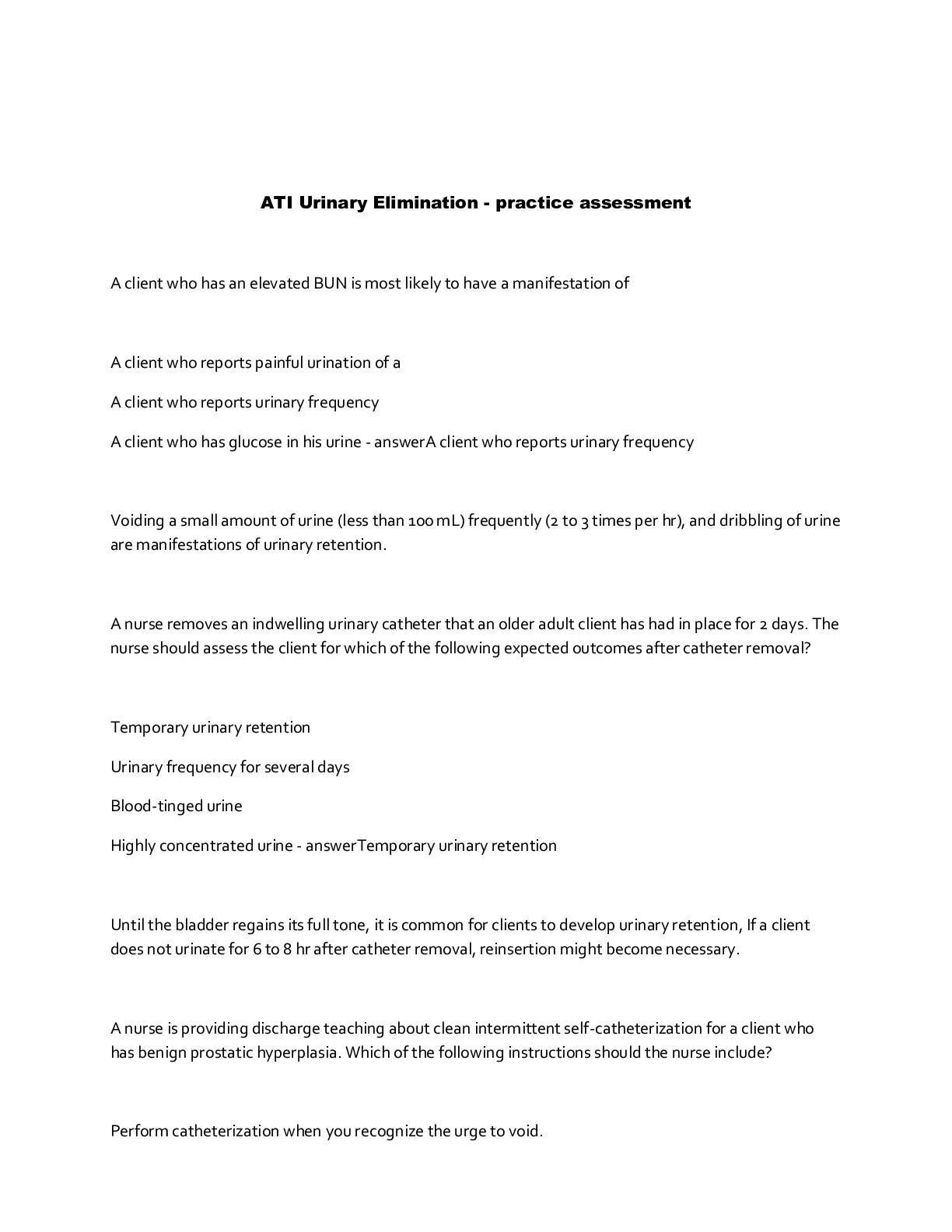
.png)
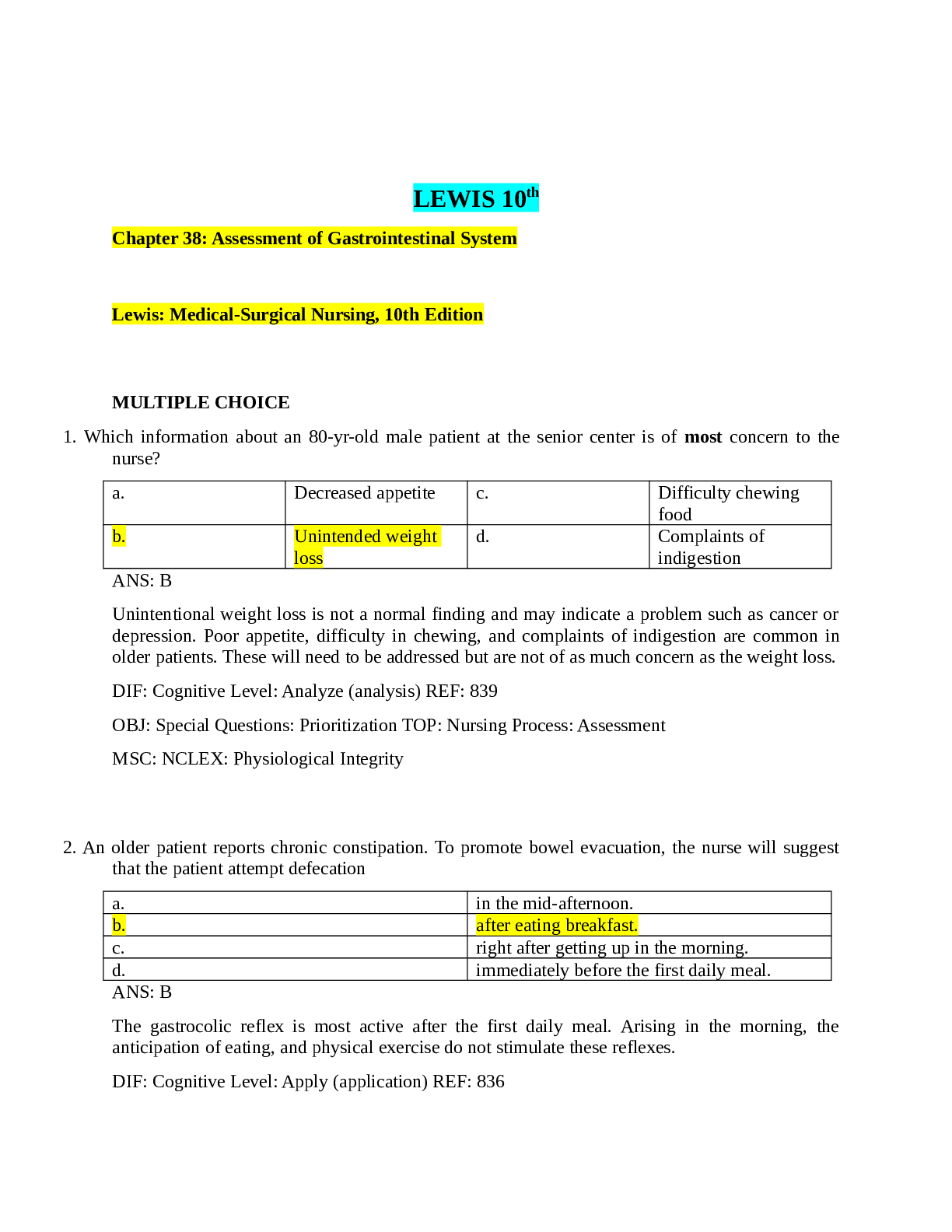

 Correct Study Guide, Download to Score A.png)
 Correct Study Guide, Download to Score A.png)
 Correct Study Guide, Download to Score A.png)
 Correct Study Guide, Download to Score A.png)
 Correct Study Guide, Download to Score A.png)
 Correct Study Guide, Download to Score A.png)
 Correct Study Guide, Download to Score A.png)
 Correct Study Guide, Download to Score A.png)
 Correct Study Guide, Download to Score A.png)

